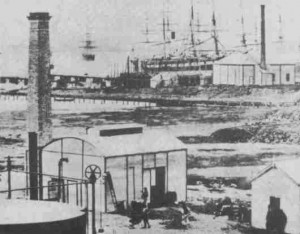- Author
- Bunnett, A, Halliburton, G and Webb, P
- Subjects
- None noted
- Tags
-
- RAN Ships
- HMAS Yarra I, HMAS Nepean, HMAS Lonsdale, HMAS Parramatta I
- Publication
- December 1971 edition of the Naval Historical Review (all rights reserved)
A Short History of HMA Naval Dockyard, Williamstown.
This is the first section of a two part article on the history of the Royal Australian Navy’s southern dockyard. The authors, Messrs. A. Bunnett, G. Halliburton and P. Webb trace the development of the dockyard in its first 60 years of development. HMA Naval Dockyard Williamstown today vies with Cockatoo Island as the Australian Navy’s premier shipbuilding yard.
With the discovery of gold in Victoria in the decade 1851-1861, the population increased sevenfold. The large fleet of vessels that brought these people into the Port of Melbourne overwhelmed the few repair facilities available. As a result, overseas vessels were often delayed in Port Phillip Bay, until slipways became vacant.
On the 20th October 1856, the Victorian Government decided to construct a large slipway at Williamstown to provide the ship repair facilities which the Port so urgently needed.
The site selected for the new Government Patent Slipway was that at present occupied by No. 1 building berth in the Naval Dockyard at Williamstown.
The first trial of the slipway was made with success on Saturday, 9th October 1858 – a date signifying the birth of the dockyard.

It soon became apparent that the docking facilities of the Port were inadequate to deal with the larger vessels arriving from overseas. The construction of the slipway took longer than estimated, and in the meantime rapid technical progress had been made in ship construction overseas.
On 20th October 1858, the decision was reached to commence the construction of a graving dock on a site between the existing Patent Slipway and Point Gellibrand.
The first of several contracts for the construction of the new graving dock was let in 1864 to Messrs. Glaister and Coy. Fortunately, before that portion of the work had been completed, news was received of the building of `ironclads’ in the United States and other ships which the dock, as originally planned, would be unable to accommodate. Arrangements were made to increase the depth and width of the dock by eight feet and ten feet respectively.
Again in 1870, doubts arose regarding the ability of the dock to meet all requirements of the future and it was decided to extend the length by fifty feet.
The foundation stone of the graving dock was laid on 4th January 1868 by HRH Prince Alfred, KG, Duke of Edinburgh, who arrived in the Royal Navy’s first ironclad, HMS Warrior.
Large excavations were necessary before the construction of the dock commenced. It was necessary to build an immense cofferdam, consisting of two curved walls, 1,000 feet in length, constructed of hardwood sheeting five inches thick.
It was completed in July 1869, when boilers, engines and pumps were placed in position and pumping operations commenced.




